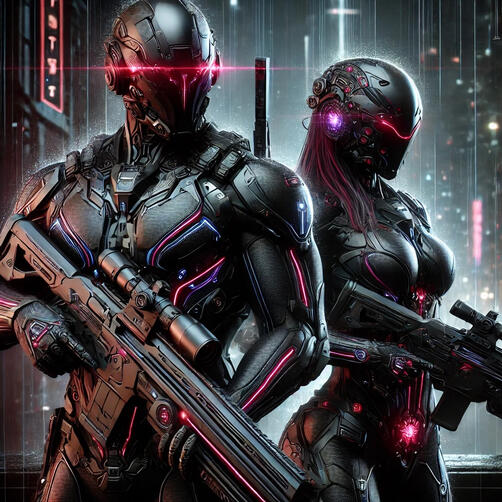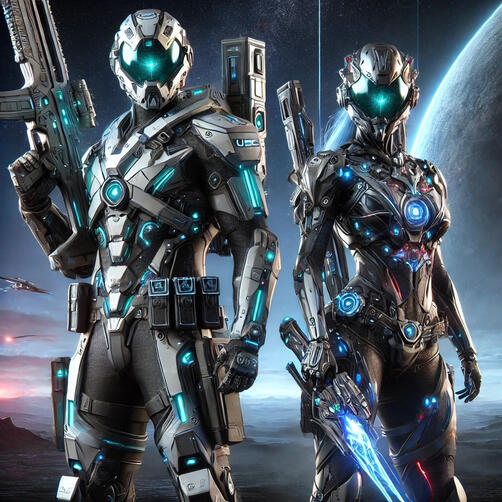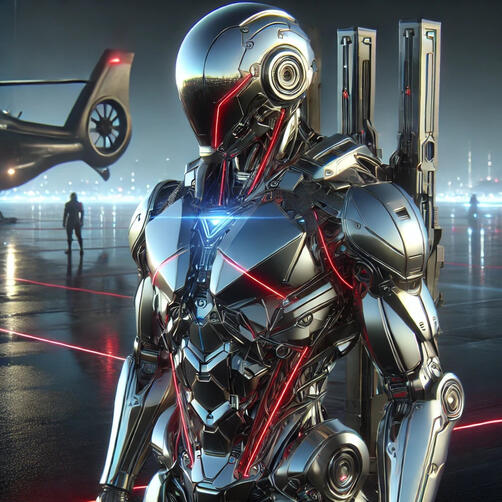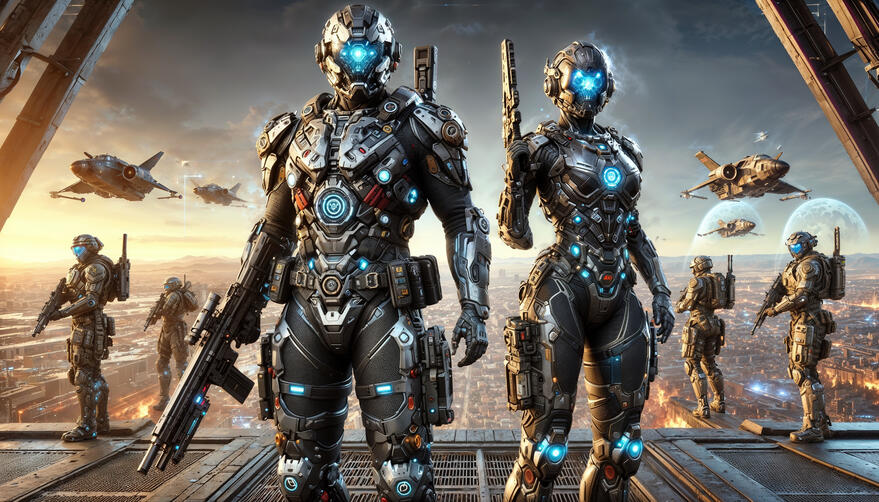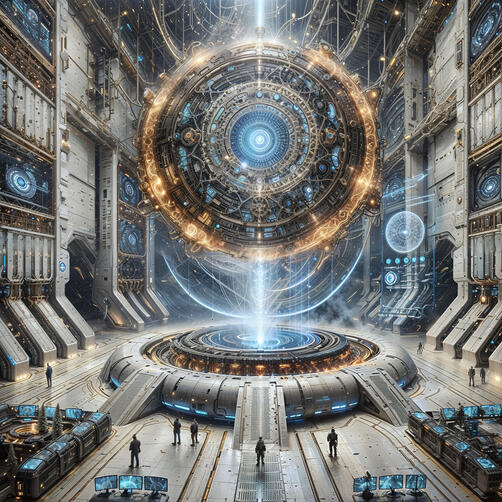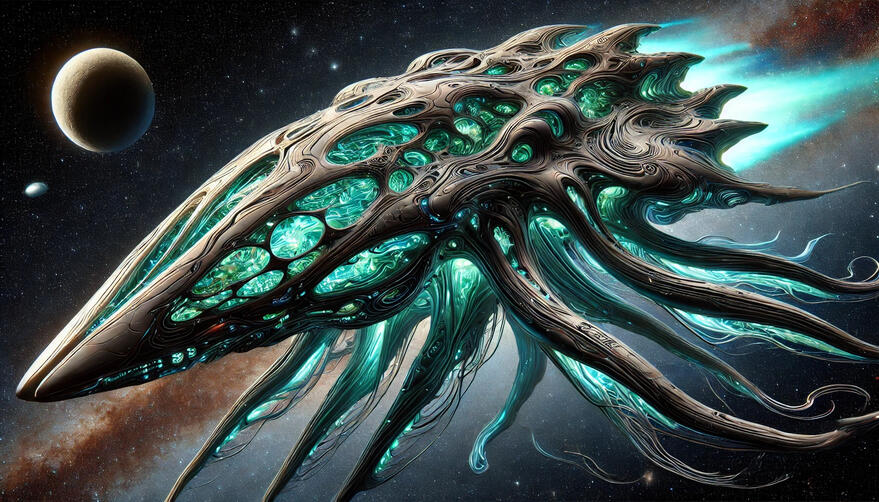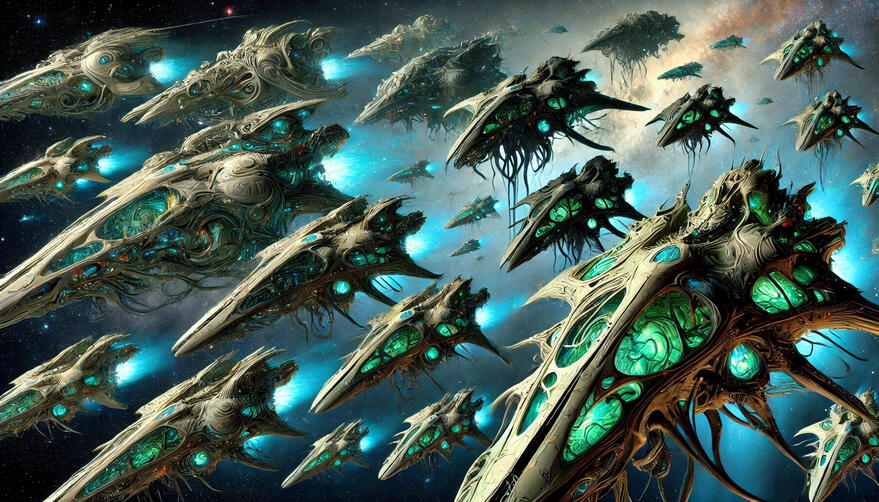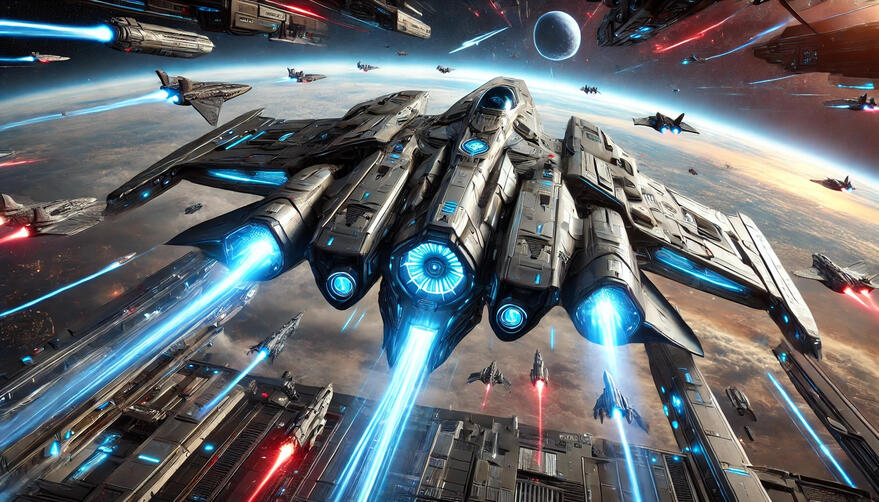
Resilience: A Post-humanity Saga™
🌌 Resilience: Humanity Perfected, Hope WeaponizedResilience is a far-future, post-singularity campaign setting for Imagine That™ TTRPG, where humanity has not fallen to dystopia—but risen through it.Set across a colonized galaxy in the year 2553 CE, Resilience chronicles the journey of a species that faced extinction, chaos, and corruption… and chose completion instead. Fusing advanced AI governance, genetic augmentation, and quantum infrastructure, Earth’s descendants no longer merely survive—they flourish. Poverty is gone. War is obsolete. Crime is a fossil. And yet, threats remain.Alien empires rise in the dark. Viral intelligences corrupt flesh and memory. Outcast human factions cling to old violence like a birthright. In this universe, utopia is not fragile—it is earned, guarded, and tested.You will walk among Paladins, Paragons, and Dark Knights—elite operatives wielding fusion-blade weaponry, psychic defenses, and AI-linked reflexes. You will command towering Chariot mechs, pilot orbital Citadel-ships, and explore ancient alien swamps where the last war drums of chaos still echo. You may serve the planetary AIs known as the DEITY Network, or reject their guidance entirely.This is not a story of collapse.
This is the story of Resilience.Campaign Features:📜 Cinematic Timeline: From the fall of modern-day nations to the rise of the Global Accord and the launch of the Citadel Initiative.⚔️ Elite Play: Custom rules for enhanced soldiers, AI-bonded operatives, and psionically resistant defenders.🤖 Faction Conflict: UEDC vs the Outsiders, Xaelok incursions, Vector infection, rogue AI cults, and more.🧠 Post-Human Themes: Explore ethics, consciousness, memory, and what it truly means to be "alive" in a galaxy of synthetic minds.🌍 Fully Customizable: Play as planetary scouts, diplomatic envoys, infected outcasts, or resistance cells cut off from the neural mesh.Genre:
Post-singularity, hard science-fantasy, AI-integrated utopian sci-fi with existential threats.
Tone:
Hopeful but haunted. Epic but intimate. Philosophical but punchy.
Primary Themes:
Ascension, Autonomy, Memory, Unity, Evolution, Redemption.“We did not flee from our flaws. We faced them, forged them, and rose beyond. We are the species that remembered how to be good. And we are not done rising.”– DEUS, Quantum AI of Earth, 2472 CE
Gallery
Class aptent taciti sociosqu ad litora torquent per conubia nostra, per inceptos himenaeos. Morbi eget metus congue, hendrerit libero eu, semper lorem.

UEDC DARK KNIGHT They do not knock. They do not announce. They enter unseen, like a dying signal in deep space. Where they tread, dissent forgets its name. And where they vanish, silence blooms like blood into water. Classification: UEDC Special Operation

Untitled

Untitled

Uerqoz

UEDC Paragon

UEDC Warcruiser

Untitled

Untitled

Untitled

Untitled

Untitled

Untitled

Untitled
The Timeline
Resilience TimelineEra I: The Collapse of Trust (2024–2029)
WWIII and the Fall of the Old GuardNovember 5, 2024 – The American Fracture Begins
Kamala Harris loses the U.S. presidential election to J.D. Vance, Trump’s chosen successor. The loss comes amid record voter suppression lawsuits, digital interference investigations, and a disillusioned Democratic base. Progressives and moderates both erupt in protest, but the courts stand by the results. Many see this as the moment the world order begins to crack.December 18, 2024 – Casus Belli
Russian forces shoot down three U.S. fighter jets providing air support to Ukrainian forces near Luhansk. Simultaneously, North Korea test-fires intermediate-range missiles that crash into Japanese waters. President Biden responds with a formal Declaration of War against both Russia and North Korea—without waiting for Congressional approval, invoking emergency executive authority.January 2, 2025 – A War of Four Fronts
With U.S. forces focused on Europe and the Korean Peninsula, China launches a full military campaign to absorb Taiwan, coordinating simultaneous air, naval, and cyber attacks. The Taiwan Strait becomes the most hotly contested war zone on the planet. Japan, South Korea, Australia, and the Philippines rally to the U.S.-led Pacific defense.March 2025 – Operation Ash Light
North Korea attempts to use tactical nuclear weapons to decapitate South Korean command centers, but is thwarted by a joint U.S.-South Korean first-strike interdiction program. Elite hacker units neutralize NK command signals, while American THAAD batteries knock out inbound missiles. Kim Jong Un disappears from public view.May–August 2025 – The Great Split Begins
With China bogged down in Taiwan and hit with cascading global sanctions, internal fractures deepen. Taiwan declares formal independence, triggering international uproar but gaining covert recognition from the West. Tibet and Hong Kong both issue unilateral declarations of autonomy. In Hunan, a powerful faction of technocrats seizes control, launching what will soon become a regional revolution in advanced cybernetics, manufacturing, and AI.October 2025 – The Treason Dossier Leaks
Anonymous whistleblowers leak files implicating former President Trump in behind-the-scenes intelligence sharing with Russia, obstruction of Ukraine-related military aid, and coercive diplomacy targeting NATO unity. Journalists and intelligence officers begin what will become a two-year criminal investigation.March 2026 – Strategic Humiliation
A GOP-majority Congress attempts to shield Trump from inquiry, but overwhelming global and national pressure leads to bipartisan defections. Democratic victories in the midterm elections of 2026 restore congressional oversight and halt MAGA efforts to extend the presidential term limits.August 2027 – Trump’s Final Impeachment
For the third time in U.S. history, Trump is impeached, this time for high treason and subversion of U.S. foreign policy. The Senate, however, fails to remove him from office due to a deadlocked vote. Despite this, public sentiment and international condemnation leave his power hollowed. The Attorney General refuses to prosecute, invoking executive privilege, drawing protests and resignations across the Department of Justice.November 7, 2028 – The Reclamation
Kamala Harris defeats J.D. Vance in a volatile and emotionally charged election. Record voter turnout, widespread support from younger and urban demographics, and the resurgence of the Democratic machine across the Rust Belt and West Coast mark a dramatic reversal of MAGA momentum. Trump's influence begins to wane as criminal charges loom.January 20, 2029 – A Gamble on the Overlooked
Kamala Harris is sworn in as President of the United States. Within weeks, she begins pivoting American foreign policy toward Africa, calling U.S. neglect of the continent a “strategic, moral, and economic failure.” In an unprecedented move, she pledges air and naval support to a secular, American-educated democratic movement in Ghana aimed at eliminating jihadist strongholds and building democratic institutions.March–October 2029 – Sparks of the Doctrine Wars
Harris’ actions in Ghana provoke international outrage from hardline theocracies and authoritarian powers. China, still smarting from its fractured influence and Taiwan’s independence, begins funding regional insurgencies in retaliation. Conservative American media brands Harris’s strategy as "imperial overreach" and "anti-Christian adventurism." But as terrorist networks are shattered in Ghana and democratic reforms gain a foothold, the Doctrine Wars quietly begin—a sprawling global struggle over secularism, agency, and ideological dominance.
Technology
Etiam gravida sem nec odio congue consequat commodo sed nisi. Maecenas at lobortis elit, nec fringilla nisl. Vestibulum vitae sed ligula sagittis mattis. Donec nec volutpat augue. Etiam placerat luctus scelerisque. Cras scelerisque mauris nec pharetra dignissim. Morbi id posuere nisi. Etiam in sapien.
Etiam gravida sem nec odio congue consequat commodo sed nisi. Maecenas at lobortis elit, nec fringilla nisl. Vestibulum vitae sed ligula sagittis mattis. Donec nec volutpat augue. Etiam placerat luctus scelerisque. Cras scelerisque mauris nec pharetra dignissim. Morbi id posuere nisi. Etiam in sapien.
Etiam gravida sem nec odio congue consequat commodo sed nisi. Maecenas at lobortis elit, nec fringilla nisl. Vestibulum vitae sed ligula sagittis mattis. Donec nec volutpat augue. Etiam placerat luctus scelerisque. Cras scelerisque mauris nec pharetra dignissim. Morbi id posuere nisi. Etiam in sapien.
Etiam gravida sem nec odio congue consequat commodo sed nisi. Maecenas at lobortis elit, nec fringilla nisl. Vestibulum vitae sed ligula sagittis mattis. Donec nec volutpat augue. Etiam placerat luctus scelerisque. Cras scelerisque mauris nec pharetra dignissim. Morbi id posuere nisi. Etiam in sapien.
Scaling aneutronic fusion reactors for a DEITY AI's planetary governance, grid, and defense system integrates planetary-wide infrastructure with the intelligence and autonomy of an advanced quantum AI. A DEITY's purpose spans from efficiently managing all aspects of human and machine life to protecting a planet against threats, both internal and external. Here's a detailed breakdown of how aneutronic fusion reactors can meet the massive power demands of such a system:
1. Core Components of a DEITY’s Planetary Network
Planetary Governance SystemAI Core:
The DEITY is a quantum AI with real-time processing of planetary logistics, decision-making, and governance tasks.
Energy Needs: 50–100 GW for quantum computation, neural network upkeep, and sub-AIs for specialized tasks.
Reactor Role: Dedicated aneutronic fusion reactors provide continuous, fail-safe energy to power the AI's core infrastructure.
Data Management:
Global data grids powered by the DEITY handle communication, commerce, and civic operations.
Distributed quantum processors linked to fusion reactors ensure redundancy.Planetary Grid ManagementUnified Power Grid:
The DEITY oversees energy distribution across cities, industries, and rural areas.
Reactor Role:
Large-scale aneutronic fusion reactors (100–500 GW) serve as the backbone of the planetary grid.
Smaller distributed reactors (5–50 GW) power remote regions, ensuring universal access.
Efficiency Enhancements:
AI-optimized load balancing minimizes energy waste and maximizes distribution.
Reactors integrate with graphene supercapacitors to store excess energy for peak demands.
Terraforming Support:
Reactors directly power planetary terraforming efforts (e.g., climate stabilization, atmospheric engineering).Planetary Defense NetworkDetection Systems:
Planet-wide quantum radar arrays and gravimetric sensors continuously monitor for threats.
Energy Needs: 10–20 GW for global sensor grids.
Reactor Role: Compact reactors at detection hubs provide the energy required for uninterrupted operation.Orbital and Ground-Based Defense Systems:
Shield Generators:
Planetary-scale particle or plasma shields protect against orbital bombardment or space-based attacks.
Energy Needs: 500 GW–1 TW during activation.
Reactor Role: Dedicated large-scale reactors sustain shield operations for extended periods.
Directed Energy Weapons:
Ground-based laser, railgun, and particle beam installations.
Energy Needs: 50–200 GW per installation during firing.
Reactor Role: High-output reactors provide instantaneous energy surges required for weapons activation.
Autonomous Defense Drones:
Swarms of AI-powered drones patrol the skies, seas, and space.
Energy Needs: 1–5 GW per swarm hub.
Reactor Role: Decentralized reactors at drone hubs ensure operational autonomy.Countermeasures Against Planetary Threats:
Anti-orbital missile systems powered by aneutronic reactors provide a rapid response to incoming threats.
Advanced EMP shielding protects reactors and systems from electromagnetic interference.2. Planet-Wide Infrastructure
Primary Energy SourcesCentral Fusion Complexes:
Several fusion power plants scattered across the planet, each generating 500 GW–1 TW, provide the bulk of planetary energy.
Located near major cities, industrial hubs, and critical infrastructure.
Connected by superconductive energy pipelines for seamless distribution.Distributed Energy SystemsSmaller fusion reactors (50–200 GW) are strategically placed in rural areas, polar regions, and oceanic installations to ensure planetary-wide coverage.
Emergency Redundancy:
Backup reactors (10–50 GW) at critical installations (e.g., hospitals, spaceports, and military bases) ensure energy supply during crises.Interconnected Smart GridThe DEITY AI optimizes energy flow based on demand, ensuring zero energy waste.
Smart Nodes:
Decentralized hubs equipped with smaller reactors (5–10 GW) act as energy distribution and storage points, ensuring localized stability.3. DEITY AI Integration
DEITY Core InfrastructureEnergy Source:
The AI core is powered by a central reactor capable of generating 100–200 GW, located within a fortified underground facility.
Redundant power supplies ensure uninterrupted operation.
Functions Powered:
Planet-wide governance, resource allocation, and crisis management.
Oversight of human settlements, agriculture, and industry.
Real-time monitoring of planetary and orbital defense systems.
Integration with Human Systems:
Direct neural uplink for Paladins, Dark Knights, and Paragons, allowing seamless AI-human cooperation.Quantum Computing NetworkMultiple quantum nodes across the planet handle parallel processing tasks for the DEITY.
Each node is powered by its dedicated aneutronic fusion reactor (5–10 GW), ensuring local autonomy and redundancy.4. Citadel-Scale Applications on the PlanetPlanetary Defense HQ:
Each Citadel II stationed on the planet has its reactors (500 GW each) to serve as both a command hub and a defense anchor.
Acts as a planetary shield generator and primary weapons platform.
Civilian Nexus:
Citadels double as civilian population centers, with aneutronic reactors powering housing, schools, hospitals, and recreational facilities.5. Terraforming and Environmental ManagementTerraforming Stations:
Powered by fusion reactors (50–100 GW each) for atmospheric stabilization, water cycle management, and soil regeneration.
Climate Control:
Global systems to regulate temperature, precipitation, and wind patterns.
Reactors (10–50 GW each) operate weather modification installations.
Oceanic Management:
Underwater reactors (5–20 GW) support desalination plants, tidal energy converters, and underwater mining operations.6. Energy Scaling for Global and Galactic ConnectivityPlanet-to-Orbit Systems:
Space elevators and mass drivers powered by aneutronic reactors facilitate the transport of resources, personnel, and spacecraft.
Orbital rings and habitats draw energy from ground-based reactors via superconductive conduits.
Galactic Communication:
Quantum entanglement communication arrays powered by 5–10 GW reactors enable instantaneous interstellar messaging.7. Defensive Gestalt Mind NetworksA planetary gestalt mind network, overseen by the DEITY, allows enhanced coordination between human, android, and AI participants.
Power Source:
Aneutronic reactors supply energy to neural uplink nodes distributed across the planet.
Applications:
Planet-wide ESP network for enhanced situational awareness.
Coordinated deployment of defensive forces during crises.ConclusionBy integrating aneutronic fusion reactors into every layer of planetary governance, grid, and defense, the DEITY system achieves unparalleled autonomy, efficiency, and resilience.
